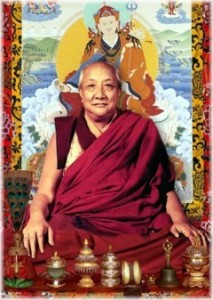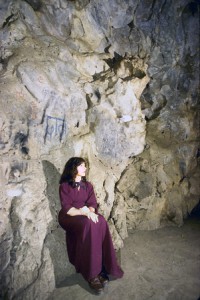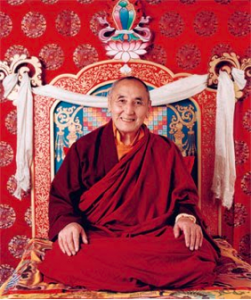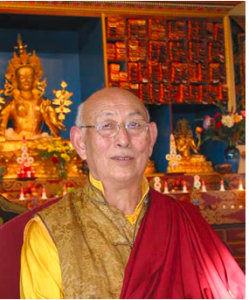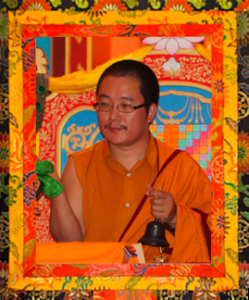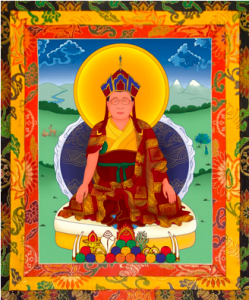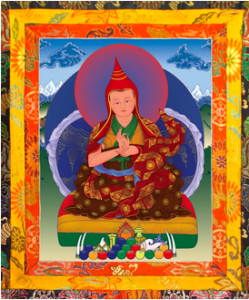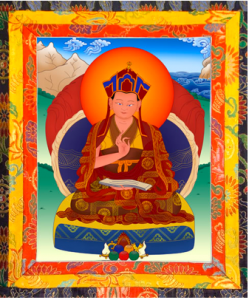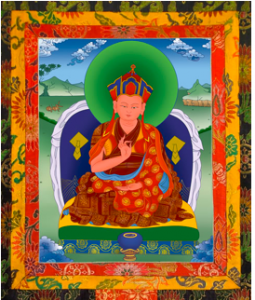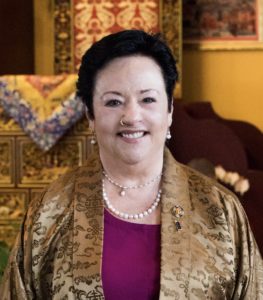
༈རྗེ་བཙུན་མ་ཨ་ཁམ་ལྷ་མོ།
རྗེ་བཙུན་སྒྲོལ་མའི་རྣམ་པར་སྤྲུལ་བ་འགྲོ་བ་མིའི་ཤ་ཚུགས་སུ་བྱོན་པ་རྗེ་བཙུན་མ་ཨ་ཁམ་ལྷ་མོ་ནི། མདོ་ཁམས་བུ་འབོར་གང་གི་ཆར་གཏོགས་པ་དཔལ་ཡུལ་ཨ་མཆོག་གྲོ་ལྷས་ཞེས་པ་སའི་དགེ་བཅུ་ཚང་བའི་ཡུལ་དུ་ཡབ་རིགས་རུས་ཀྱི་མངོན་པར་མཐོ་བ་དམུ་ཚ་སྒའི་རིགས་རྒྱུད་རྡོ་རྗེ་དང། ཡུམ་ཡེ་ཤེས་མཁའ་འགྲོ་མ་གུ་རུ་མཚོ་གཉིས་ཀྱི་སྲས་མོར་བོད་རབ་བྱུང་༡༡་པའི་དཀྱིལ་སྨད་ཙམ་དང་སྤྱི་ལོ་དུས་རབས་༡༧་པའི་སྨད་ཙམ་དུ་ངོ་མཚར་བའི་ལྟས་དུ་མ་དང་བཅས་ཏེ་རིག་འཛིན་ཆེན་པོ་ཀུན་བཟང་ཤེས་རབ་ཀྱི་གཅུང་མོ་ཆུང་བར་སྐུ་འཁྲུངས་ཤིང་། སྐུ་ན་ཆུང་དུས་ནས་ཡི་གེ་འབྲི་ཀློག་སོགས་བསླབ་པ་ཙམ་གྱིས་ཚེགས་མེད་པ་མཁྱེན་པ་བྱུང་། རིག་འཛིན་ཀུན་བཟང་ཤེས་རབ་དང་མཉམ་དུ་སྔ་གཞུག་རྣམས་སུ་གཏེར་སྟོན་ཆེན་པོ་མི་འགྱུར་རྡོ་རྗེ་དང་། ཅོག་རོ་ཀླུའི་རྒྱལ་མཚན་གྱི་ཟློས་གར་མཁས་གྲུབ་ཀརྨ་ཆགས་མེད་རྣམ་གཉིས་ཀྱི་གཙོས་མཁས་ཤིང་གྲུབ་པ་བརྙེས་པའི་སྐྱེས་ཆེན་དུ་མའི་ཞབས་རྡུལ་སྤྱི་བོར་བླངས་ནས་མདོ་རྒྱུད་རྒྱུད་སྡེ་རབ་འབྱམས་ལ་ཐོས་བསམ་གྱིས་སྒྲོ་འདོགས་ལེགས་པར་བཅད་དེ། གནས་ངེས་མེད་རྣམས་སུ་བྱོན་ནས་སྒྲུབ་པ་ཉམས་ལེན་ལ་རྩེ་གཅིག་ཏུ་གཞོལ་བར་མཛད་ནས་ལྷག་པའི་ལྷ་རབ་འབྱམས་ཀྱི་ཞལ་གཟིགས་ཤིང་ལུང་བསྟན་དུ་མ་ཐོབ། འདིར་སྣང་གི་འཁྲུལ་པ་ཀ་དག་སྤྲོས་བྲལ་གྱི་དབྱིངས་སུ་རང་སར་དག་ནས་ཆོས་སྐུ་ཀུན་ཏུ་བཟང་པོའི་རྒྱལ་ཐབས་ལ་མངའ་དབང་འབྱོར་ཞིང་། དཔལ་ཡུལ་རྣམ་རྒྱལ་བྱང་ཆུབ་ཆོས་གླིང་གི་ཤར་ཐད་ཀྱི་རི་སུལ་དུ་བཞུགས་ཏེ། བཙུན་མའི་འཁོར་སློབ་མང་དུ་འདུས་པ་རྣམས་ལ་ཆོས་ཀྱི་འཁོར་ལོ་བར་མེད་དུ་བསྐོར་བར་མཛད་ཅིང་རིམ་གྱིས་དགོན་སྡེ་ཆགས་པས་ཇོ་དགོན་གདོང་ཞེས་པའི་མཚན་དང་། ན་བཟའ་དམར་པོ་མནབ་པའི་ཨ་ནེ་ཇོ་མོས་གང་བས་གྲོང་དམར་སྟེང་ཞེས་མིང་དེ་དག་དེ་ནས་ཐོགས་པར་བྱུང་། མདོར་ན་རྗེ་བཙུན་མ་འདི་ཉིད་ཀྱིས་བཤད་སྒྲུབ་ཀྱི་འཁོར་ལོ་གཉིས་ལྡན་གྱི་གོ་ནས་འཁོར་གདུལ་བྱ་དུ་མ་བསྐྱངས་ཏེ། མཁས་གྲུབ་གཉིས་ལྡན་གྱི་གོ་འཕང་ལ་མངའ་དབང་འབྱོར་བའི་འཁོར་དུ་མ་སྨིན་པར་མཛད་ཅིང་། ཞིང་འདིའི་གདུལ་བྱ་དེ་ཙམ་གཟིགས་ནས། མཐར་ཆོས་ཉིད་ཞི་བའི་དབྱིངས་སུ་གཤེགས་ནས་གདུང་ཞུགས་ལ་འབུལ་སྐབས་དབུ་ཐོད་ནམ་མཁར་ཡར་ནས་སྔར་རིག་འཛིན་ཆེན་པོའི་ཆོས་གསུང་ཡུལ་གྱི་ཆོས་ཁྲི་སྟེང་གི་སྤང་ཁར་བབས་པས། དེ་ཕྱིན་ཆད་དམ་པའི་སྐྱེས་ཆེན་དག་གི་སྐུ་གདུང་ཞུགས་འབུལ་བྱ་ཡུལ་དང་དུར་གླིང་དུ་གྱུར། དབུ་ཐོད་དེ་སྒྲུབ་ཆེན་བྱིན་འབེབས་སྐབས་ཐོད་གཡབ་མཛད་ཅིང་ད་ལྟ་ཡང་བཞུགས་ཤིང་། ཁོང་གྱི་རྣམ་འཕྲུལ་བག་ཆགས་སད་པའི་ལས་ཅན་མ་ཞིག་ད་ལྟ་ཨ་རིའི་རྒྱལ་ཁབ་ཏུ་འཁྲུངས་ཡོད་པར་ཐོས་སོ།།
Jetsunma Ah Kham Lhamo
Birth
Ah Kham Lhamo, the emanation of Noble Tara, the mother of all Buddhas, took the form of a human being, in Palyul Achog Dro Lhae, a province of Dokham Bubor Gang, the land with complete signs of the ten virtues. Her father, Dorjee, was from the noble family of Mutsa Ga, and her mother, Guru Tsho, was a Wisdom Dakini. She was born just after the second half of the 11th Rabjung cycle, which is around the end of the 17th century. At her birth, there were many amazing signs. She was the younger sister of Rigzin Kunzang Sherab.
Education
At a very early age, she was able to master reading and writing without any difficulties. On many occasions she accompanied Kunzang Sherab, to receive teachings from the Great Terton Migyur Dorjee, Karma Chagmed (who was the emanation of Chokro Luyi Gyeltshen), and many other great accomplished scholars and mahasiddhas of that time. Under their guidance she mastered the sutras and the tantras–especially the infinite tantras–and cleared any misunderstanding of them, with her wisdom of hearing and wisdom of contemplation.
Practices and retreats
Then she wandered in many sacred places and practiced with single-pointed perseverance. She had the visions of unfathomable deities and received many revelations from them. She purified the delusion of ordinary perception into the expanse of the primordially pure state, free of all elaborations, and gained mastery over the kingdom of Dharmakaya Samantabadra.
Benefiting Beings
She resided on the hill to the east of Palyul Namgyal Jangchub Choling where she constantly turned the Wheel of Dharma to her disciples of nuns. Gradually, it became a nunnery and was called Jo Gon Dong. Because the place was filled with nuns in their maroon robes, it was also called Upper Red Village. Thus the place got its names.
Conclusion
In brief, Jetsunma cared for and benefited countless beings to be tamed by the wheel of teachings and practices. She ripened the minds of her followers, and many became great scholars and accomplished practitioners.
Finally, seeing that her benevolent activities had come to an end, she entered the peaceful state of dharmadhatu. When her holy body was cremated, her skull jumped up in the sky and fell on the throne that Rigzin Kunzang Sherab used to give teachings. This site later became the cremation ground of the holy lamas.
The skull was used to invoke the blessings of the deities during the Drubchen practices. It is still with us.
I have heard that her emanation, a lady with fortunate karma, who had awakened in the experience of the past, has been born in America.
This is the life and liberation of Jetsunma Ahkon Lhamo, from the History of the Palyul Lineage written by Tulku Thubten Palzang.
